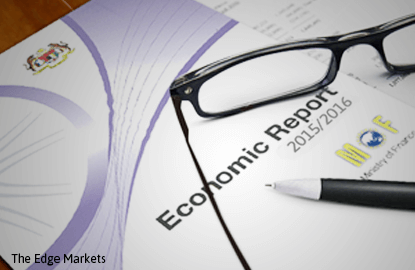
This article first appeared in The Edge Malaysia Weekly, on October 26 - November 1, 2015.
MALAYSIA’S fiscal consolidation will continue in 2016 despite lower oil-related receipts, with the budget deficit targeted to be reduced to 3.1% from 3.2% this year and 3.4% last year, according to the Economic Report 2015/16.
This will be done through “consistent structural reform initiatives”, which include “improvements to fiscal policy governance” through the establishment of the Fiscal Policy Committee, which has endorsed a Medium-Term Fiscal Framework “as a tool to formulate fiscal strategies and determine multi-year expenditure ceilings over the medium term”, says the report.
In absolute terms, however, the budget deficit is expected to increase 4.1% to RM38.78 billion next year from RM37.25 billion this year.
Despite the higher absolute spending, a fiscal balance improvement will be enabled by a bigger Malaysian economy next year. The country’s GDP is expected to reach RM1.11 trillion by then from RM1.06 trillion this year. The continued fiscal consolidation will also be helped by subsidy rationalisation.
The government expects a 1.4% increase in revenue to RM225.66 billion in 2016, which will mainly stem from higher income tax collection from corporates totalling RM74.38 billion and higher Goods and Services Tax (GST) collection of RM39 billion.
The expected GST receipts are significantly higher than the RM27 billion estimated for the nine months of this year (which, if annualised, would have been RM36 billion for the full year), given that the tax was only implemented on April 1.
It is worth noting that receipts from petroleum income tax is expected to decline 9.4% to RM9.33 billion due to lower oil prices while investment income is seen to ease by 4.4% to RM21.45 billion.
In terms of operating expenditure, which can be likened to overhead expenses for businesses, the government expects it to expand 0.9% year on year to RM215.22 billion. Emoluments will continue to make up the largest portion of the expenditure at RM70.47 billion (32.7% of total operating expenses), slightly higher than the RM69.11 billion (32.4%) in 2015.
Debt service charges are also expected to increase 9.3% y-o-y to RM26.64 billion next year compared with RM24.38 billion this year and RM22.59 billion last year. On this, the Ministry of Finance has assured that 97% of federal government debt is ringgit-denominated and has fixed coupon rates, reducing the risk associated with currency exchange and interest rate.
Meanwhile, subsidies — which include incentives for farmers and fishermen, social welfare programmes as well as subsidies for cooking oil, liquefied natural gas and petrol used in public transport — are expected to be trimmed by 0.5% to RM26.1 billion, as the government looks to targeted subsidies.
As for development expenditure, the allocation has been increased by 5.4% to RM50 billion from RM47.4 billion this year, representing 19.2% of the total ceiling of RM260 billion under the 11th Malaysia Plan. Out of this, the economic sector (transport, agriculture and rural development, trade and industry) will be provided RM30.3 billion, the social sector (education, health and housing) RM13.09 billion and the security sector, RM5.01 billion.
Given the uncertainties surrounding oil prices, the size of the GST collection could play a bigger role in determining whether the government achieves its targeted 3.1% budget deficit next year, economists say.
“If the GST collection can hit RM39 billion, then the fiscal deficit reduction is achievable,” Hong Leong Investment Bank economist Sia Ket Ee said, noting that the expected collection is “even stronger than the government’s earlier guidance of RM32 billion”.
Sia also said the government’s oil-related revenue projection is achievable as the government’s projection of oil prices at US$48 per barrel in 2016 is conservative, being at the lower end of Hong Leong’s forecast of US$45 to US$55 per barrel.
“If there is any (positive) change in the oil market, that will represent an upside potential to the government’s financial position next year,” he added.
“In a worst case scenario, they can cut development expenditure in 2016 to meet the deficit target,” says another economist, who prefers that operating expenditure can be cut instead, should there be a revenue shortfall next year.
For now, Sia reckons that the government is on the right track on fiscal consolidation but much of its efficacy will depend on how well it can win back investors. “When the sentiment improves, then we will see other improvements such as portfolio investments and the ringgit story,” he said.
On whether a 3.1% budget deficit target for 2016 is a disappointment, given initial expectations for it to reach 3% this year prior to the revision to 3.2% following the fall in oil prices, another economist say any shortfall would have to be made up by year 2020 where a balanced budget is targeted.
Save by subscribing to us for your print and/or digital copy.
P/S: The Edge is also available on Apple's AppStore and Androids' Google Play.